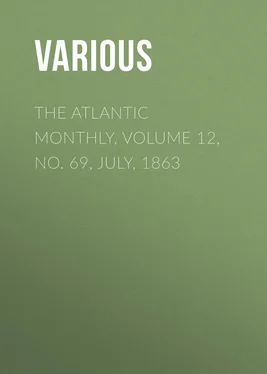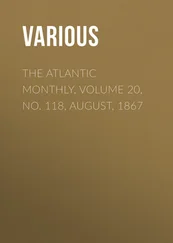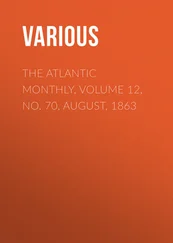Various - The Atlantic Monthly, Volume 12, No. 69, July, 1863
Здесь есть возможность читать онлайн «Various - The Atlantic Monthly, Volume 12, No. 69, July, 1863» — ознакомительный отрывок электронной книги совершенно бесплатно, а после прочтения отрывка купить полную версию. В некоторых случаях можно слушать аудио, скачать через торрент в формате fb2 и присутствует краткое содержание. Жанр: foreign_antique, periodic, foreign_edu, на английском языке. Описание произведения, (предисловие) а так же отзывы посетителей доступны на портале библиотеки ЛибКат.
- Название:The Atlantic Monthly, Volume 12, No. 69, July, 1863
- Автор:
- Жанр:
- Год:неизвестен
- ISBN:нет данных
- Рейтинг книги:4 / 5. Голосов: 1
-
Избранное:Добавить в избранное
- Отзывы:
-
Ваша оценка:
- 80
- 1
- 2
- 3
- 4
- 5
The Atlantic Monthly, Volume 12, No. 69, July, 1863: краткое содержание, описание и аннотация
Предлагаем к чтению аннотацию, описание, краткое содержание или предисловие (зависит от того, что написал сам автор книги «The Atlantic Monthly, Volume 12, No. 69, July, 1863»). Если вы не нашли необходимую информацию о книге — напишите в комментариях, мы постараемся отыскать её.
The Atlantic Monthly, Volume 12, No. 69, July, 1863 — читать онлайн ознакомительный отрывок
Ниже представлен текст книги, разбитый по страницам. Система сохранения места последней прочитанной страницы, позволяет с удобством читать онлайн бесплатно книгу «The Atlantic Monthly, Volume 12, No. 69, July, 1863», без необходимости каждый раз заново искать на чём Вы остановились. Поставьте закладку, и сможете в любой момент перейти на страницу, на которой закончили чтение.
Интервал:
Закладка:
In our former articles we have spoken principally of stereoscopic pictures. These are still our chief favorites for scenery, for architectural objects, for almost everything but portraits,—and even these last acquire a reality in the stereoscope which they can get in no other way. In this third photographic excursion we must only touch briefly upon the stereograph. Yet we have something to add to what we said before on this topic.
One of the most interesting accessions to our collection is a series of twelve views, on glass, of scenes and objects in California, sent us with unprovoked liberality by the artist, Mr. Watkins. As specimens of art they are admirable, and some of the subjects are among the most interesting to be found in the whole realm of Nature. Thus, the great tree, the "Grizzly Giant," of Mariposa, is shown in two admirable views; the mighty precipice of El Capitan, more than three thousand feet in precipitous height,—the three conical hill-tops of Yo Semite, taken, not as they soar into the atmosphere, but as they are reflected in the calm waters below,—these and others are shown, clear, yet soft, vigorous in the foreground, delicately distinct in the distance, in a perfection of art which compares with the finest European work.
The "London Stereoscopic Company" has produced some very beautiful paper stereographs, very dear, but worth their cost, of the Great Exhibition. There is one view, which we are fortunate enough to possess, that is a marvel of living detail,—one of the series showing the opening ceremonies. The picture gives principally the musicians. By careful counting, we find there are six hundred faces to the square inch in the more crowded portion of the scene which the view embraces,—a part occupied by the female singers. These singers are all clad in white, and packed with great compression of crinoline,—if that, indeed, were worn on the occasion. Mere points as their faces seem to the naked eye, the stereoscope, and still more a strong magnifier, shows them with their mouths all open as they join in the chorus, and with such distinctness that some of them might readily be recognized by those familiar with their aspect. This, it is to be remembered, is not a reduced stereograph for the microscope, but a common one, taken as we see them taken constantly.
We find in the same series several very good views of Gibson's famous colored "Venus," a lady with a pleasant face and a very pretty pair of shoulders. But the grand "Cleopatra" of our countryman, Mr. Story, of which we have heard so much, was not to be had,—why not we cannot say, for a stereograph of it would have had an immense success in America, and doubtless everywhere.
The London Stereoscopic Company has also furnished us with views of Paris, many of them instantaneous, far in advance of the earlier ones of Parisian origin. Our darling little church of St. Etienne du Mont, for instance, with its staircase and screen of stone embroidery, its carved oaken pulpit borne on the back of a carved oaken Samson, its old monuments, its stained windows, is brought back to us in all its minute detail as we remember it in many a visit made on our way back from the morning's work at La Pitié to the late breakfast at the Café Procope. Some of the instantaneous views are of great perfection, and carry us as fairly upon the Boulevards as Mr. Anthony transports us to Broadway. With the exception of this series, we have found very few new stereoscopic pictures in the market for the last year or two. This is not so much owing to the increased expense of importing foreign views as to the greater popularity of card-portraits , which, as everybody knows, have become the social currency, the sentimental "green-backs" of civilization, within a very recent period.
We, who have exhausted our terms of admiration in describing the stereoscopic picture, will not quarrel with the common taste which prefers the card-portrait. The last is the cheapest, the most portable, requires no machine to look at it with, can be seen by several persons at the same time,—in short, has all the popular elements. Many care little for the wonders of the world brought before their eyes by the stereoscope; all love to see the faces of their friends. Jonathan does not think a great deal of the Venus of Milo, but falls into raptures over a card-portrait of his Jerusha. So far from finding fault with him, we rejoice rather that his affections and those of average mortality are better developed than their taste; and lost as we sometimes are in contemplation of the shadowy masks of ugliness which hang in the frames of the photographers, as the skins of beasts are stretched upon tanners' fences, we still feel grateful, when we remember the days of itinerant portrait-painters, that the indignities of Nature are no longer intensified by the outrages of Art.
The sitters who throng the photographer's establishment are a curious study. They are of all ages, from the babe in arms to the old wrinkled patriarchs and dames whose smiles have as many furrows as an ancient elm has rings that count its summers. The sun is a Rembrandt in his way, and loves to track all the lines in these old splintered faces. A photograph of one of them is like one of those fossilized sea-beaches where the raindrops have left their marks, and the shellfish the grooves in which they crawled, and the wading birds the divergent lines of their foot-prints,—tears, cares, griefs, once vanishing as impressions from the sand, now fixed as the vestiges in the sand-stone.
Attitudes, dresses, features, hands, feet, betray the social grade of the candidates for portraiture. The picture tells no lie about them. There is no use in their putting on airs; the make-believe gentleman and lady cannot look like the genuine article. Mediocrity shows itself for what it is worth, no matter what temporary name it may have acquired. Ill-temper cannot hide itself under the simper of assumed amiability. The querulousness of incompetent complaining natures confesses itself almost as much as in the tones of the voice. The anxiety which strives to smooth its forehead cannot get rid of the telltale furrow. The weakness which belongs to the infirm of purpose and vacuous of thought is hardly to be disguised, even though the moustache is allowed to hide the centre of expression .
All parts of a face doubtless have their fixed relations to each other and to the character of the person to whom the face belongs. But there is one feature, and especially one part of that feature, which more than any other facial sign reveals the nature of the individual. The feature is the mouth , and the portion of it referred to is the corner . A circle of half an inch radius, having its centre at the junction of the two lips will include the chief focus of expression.
This will be easily understood, if we reflect that here is the point where more muscles of expression converge than at any other. From above comes the elevator of the angle of the mouth; from the region of the cheek-bone slant downwards the two zygomatics , which carry the angle outwards and upwards; from behind comes the buccinator , or trumpeter's muscle, which simply widens the mouth by drawing the corners straight outward; from below, the depressor of the angle; not to add a seventh, sometimes well marked,—the "laughing muscle" of Santorini. Within the narrow circle where these muscles meet the ring of muscular fibres surrounding the mouth the battles of the soul record their varying fortunes and results. This is the " noeud vital "—to borrow Flourens's expression with reference to a nervous centre,—the vital knot of expression. Here we may read the victories and defeats, the force, the weakness, the hardness, the sweetness of a character. Here is the nest of that feeble fowl, self-consciousness, whose brood strays at large over all the features.
Читать дальшеИнтервал:
Закладка:
Похожие книги на «The Atlantic Monthly, Volume 12, No. 69, July, 1863»
Представляем Вашему вниманию похожие книги на «The Atlantic Monthly, Volume 12, No. 69, July, 1863» списком для выбора. Мы отобрали схожую по названию и смыслу литературу в надежде предоставить читателям больше вариантов отыскать новые, интересные, ещё непрочитанные произведения.
Обсуждение, отзывы о книге «The Atlantic Monthly, Volume 12, No. 69, July, 1863» и просто собственные мнения читателей. Оставьте ваши комментарии, напишите, что Вы думаете о произведении, его смысле или главных героях. Укажите что конкретно понравилось, а что нет, и почему Вы так считаете.












